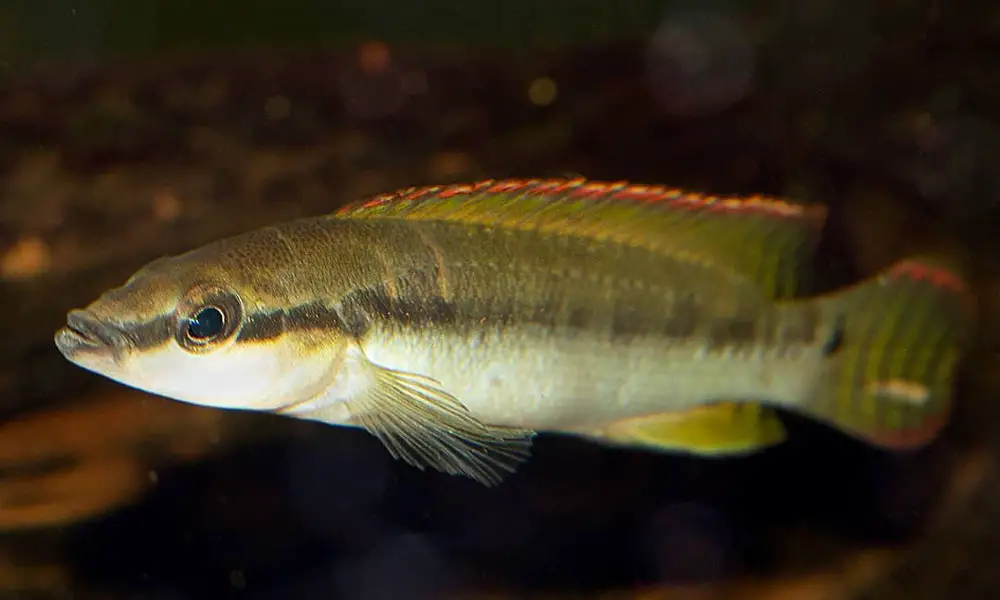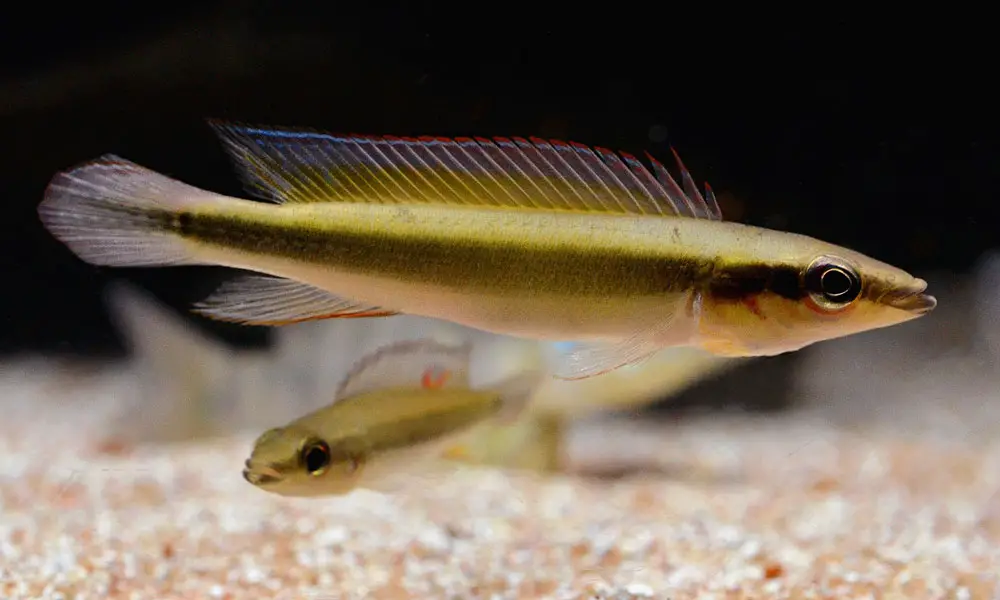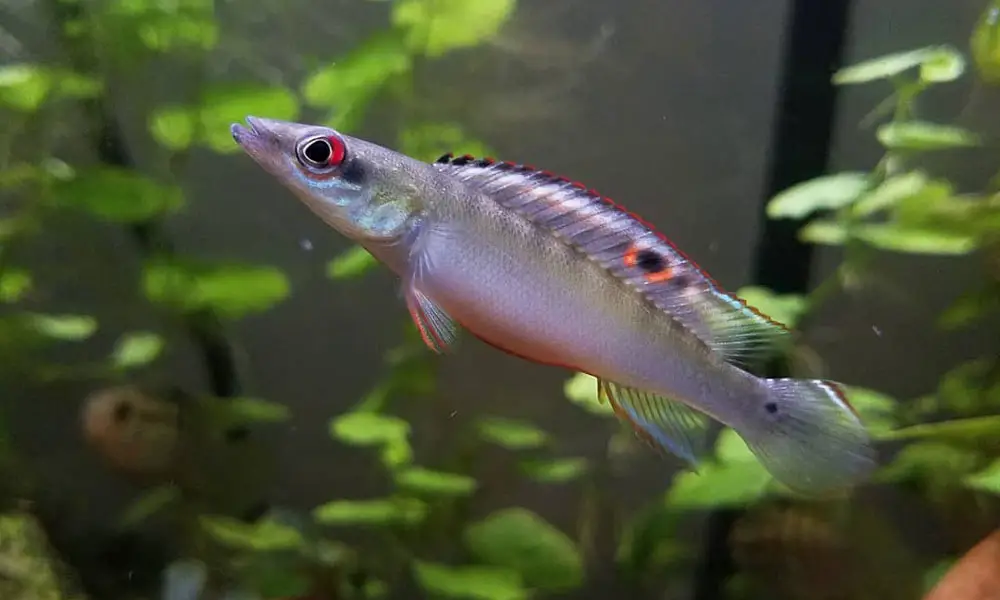Dwarf Pike Cichlids often get a bad rap, with many viewing them as delicate and temperamental fish.
While it’s true they do have particular tank requirements and may have some aggressive tendencies, with proper care, these small South American cichlids can make a beautiful and energetic addition to your home aquarium.
Below you’ll learn everything you need to know about Dwarf Pike Cichlids, from how to set up the right environment to what foods they eat and how to work with their aggression issues. By the end of this article, you’ll be equipped to handle these predators like a pro!
Species Overview
If you’re looking for taxonomic information on the Dwarf Pike Cichlids, you may run into a bit of trouble- while you’ll find plenty of references to the genus Crenicichla, this common name will be all over the place! So what gives? It turns out “Dwarf Pike Cichlid” is a more general name used by aquarists for a number of small Crenicichla species.
Crenicichla is a genus of South American fish under the family Cichlidae containing over 100 species. Dwarf Pike Cichlids comprise any members of this genus that do not exceed 5 ½ inches (14 cm) in length once mature.
These fish are native to a variety of habitats throughout the Amazon basin, from tepid lakes to fast-flowing river rapids. C. compressiceps, for example, inhabits the rapids of Rio Tocantins. C. nopthalmus and C. regani, on the other hand, can be found in the comparatively still waters of the Rio Negro and the Rio Trombetas, respectively.
Common Types of Dwarf Pike Cichlids
Despite the fact that only 11 recognized species are divided into the Dwarf Crenicichla group, not all of these can be found in the aquarium trade. Here are the three most kept species among aquarists.
Crenicichla compressiceps

C. compressiceps is probably the most popular of their family in the fishkeeping community since it’s the first Dwarf Crenicichla species to be officially described (Ploeg 1986). This fish has a greenish body with 6-8 narrow, yellow stripes running vertically along its sides. The tail, anal, and caudal fins also have black vertical bands.
Being a dwarf species, this fish only grows up to a maximum of 4 inches (10 cm) and typically averages 3 inches (8 cm). However, it’s one of the most territorial species, so it’s better to keep them in larger tanks.
Crenicichla notophthalmus

C. notophthalmus, native to the lower Negro River basin, has the characteristic features of these dwarf Crenicichla, with an elongated body and a wide mouth.
Although the average size of full-grown C. notophthalmus is around 3 inches (7.6 cm), this fish is more difficult to keep and breed in a home aquarium due to its specific water requirements.
Crenicichla regani

C. regani, commonly known as Regani Dwarf Pike Cichlid, is the most peaceful Dwarf Pike Cichlid, which is found in clearwater rivers in the Brazilian Amazon.
This species is my favorite pike cichlid, given its peaceful nature and beautiful coloration. It usually grows to the maximum length of 3 inches (7.6 cm) and goes well in groups in my South American Cichlid Community. To begin with dwarf Crenicichla, C. regani will be your best bet.
How Long Do Dwarf Pike Cichlids Live?
With proper care, some dwarf pike cichlids can live from 4-6 years in captivity– an impressive lifespan for such a small fish!
That’s the estimated lifespan. As always, there’s no guarantee that your fish will live for the full duration of its lifespan. Proper care and environmental conditions are key to giving your fish the best chance at living a long, healthy life.
How Big Do Dwarf Pike Cichlids Get?
While Pike Cichlids in general can vary wildly in their adult size, by definition, Dwarf Pike Cichlids are on the smaller end of the spectrum. Most species fall within the range of 3-4 inches when fully grown and max out at around 5 ½ inches.
As there are many varieties of dwarf pike cichlid available, be sure to research the specific species you’re thinking of purchasing to find out its maximum size.
Setting Up the Tank: Dwarf Pike Cichlid Care
As with all things relating to these alluring little fish, the care and keeping of your Dwarf Pike Cichlid will depend heavily on the species, though there are some good general rules of thumb to go by.
Tank Size
While small in stature, Dwarf Pike Cichlids definitely wouldn’t be the first choice of fish for a minimalist. Though tank size will, of course, depend on the fish itself, in general, a tank of no larger than 30 gallons should be reserved for only the smallest and most docile of cichlids like C. Regani.
For the more territorial species such as C. Compressiceps, 55 gallons would be the minimum tank size to keep your fish living healthily and harmoniously. C. Notophthalmus, meanwhile, is right in the middle, requiring a 45-gallon tank for an adult fish.
It is important to remember that smaller tanks require more frequent maintenance, as this limits the amount of fresh water available. Therefore, choosing a larger tank than the minimum recommended size can be beneficial.
Water Parameters
Dwarf Pike Cichlids require very well-filtered and well-aerated water. As their natural habitats tend to be bodies of clear fresh water, these species can be especially sensitive to a dirty or unbalanced tank.
Most members of the genus Crenicichla are warm-water fish, so the ideal temperature tends to be on the higher side—between 77°F and 82°F (25°C and 28°C) for most varieties. They prefer soft water, with a hardness of around 5 to 10 dGH.
The exact pH requirement will also depend on the species, though we’ve provided a handy reference below for some of the more common types.
| Species | pH |
|---|---|
| C. Compressiceps | 5.0 to 6.8 |
| C. Notophthamlus | 6.5 to 7.5 |
| C. Regani | 6.0 to 7.2 |
Decor (Plants and Substrate)
Crenicichla species require a loose, diggable substrate like sand or fine gravel. Driftwood and floating plants are a must for replicating the fish’s native environment. Plants that grow on driftwood, like Anubias or Microsorum, are popular choices, as any plants that are grown in the substrate run the risk of being uprooted.
These fish can be a bit shy, so it’s best to provide plenty of hiding spots. If you want to keep a more natural aesthetic in your tank, driftwood, stones, and dead leaves can all be great options for this. Ceramic pipes are another popular choice for making sure your fish feels safe and secure.
Behavior and Temperament

In general, Pike cichlids have a reputation for aggression, and to a certain extent, this is accurate. These are predatory fish by nature, and as such, they may display violent tendencies toward anything they perceive as food.
They can also be fairly active and territorial, which is another reason why ensuring a properly-sized tank for the amount of fish you want to keep is so important. You wouldn’t want your cichlids all crammed together in there!
C. compressiceps tends to be the worst offender when it comes to aggression, with C. notophthalmus and C. regani being more mellow in disposition.
Dwarf Pike Cichlid Tank Mates
As previously mentioned, Dwarf Pike Cichlids are predatory fish. This does limit the variety of tankmates you can keep with your cichlids, as they have a tendency to view anything smaller and/or weaker than them as food.
Catfish, eartheaters, tetras tend to be good options, as these fish are too large for the Dwarf Pike Cichlid to pose much of a threat. They can also be housed together with other peaceful, large SA cichlids, though care must be taken in this case to ensure they are too large for your Crenicihla to eat.
Here are some of potential Dwarf Pike Cichlid tank mates:
- Large tetras
- Medium sized catfish
- Geophagus Brasiliensis (Pearl Cichlid)
- Geophagus altifrons
- Geophagus sveni (Sven’s Eartheater Cichlid)
- Electric Blue Acara
- Keyhole Cichlid (Cleithracara maronii)
- Small Rainbowfish
Food & Diet
There is some debate over whether pellet feeding is appropriate for Dwarf Pike Cichlids. The general consensus we’ve found is that while some wild-caught specimens may have difficulty with commercial fish foods, captive-bred fish can be pellet trained quite easily.
As these species are not surface eaters, it’s important to select fish food that sinks.
If your fish is wild-caught, there is a chance it may only accept live food. If this is the case, keeping a few companion fish in the tank can be vital. Cichlids are very fast learners and will usually take to frozen foods once they’ve seen the other fish eat them.
Barring any picky eaters, Dwarf Pike Cichlids benefit from a varied diet, including small insects and crustaceans like bloodworms, mosquito larvae, and brine shrimp. These can be served up either live or frozen, depending on preference.
Final Thoughts
Hopefully our Dwarf Pike Cichlid care guide has given you a better understanding of this fascinating group of fish that can make a vibrant addition to your home aquarium.
While they can be a bit finicky and may be a bit daunting for beginner aquarists when given the proper care, these cute little fish can make excellent companions for years to come.
If you happen to have any questions or would like to share your stories, please feel free to leave a comment below. We’d love to hear from you!
Happy Fishkeeping!
